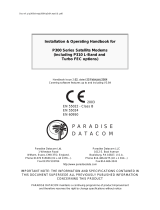
Isolated Ground Post
Using an isolated ground wire can eliminate
ground potential difference problems and
provide a more reliableground connection.
Before attaching the isolated ground wire to
the grounding post on the P300 the internal
ground wire must be disconnected.
Place the P300 on its back so the underside
is exposed. Remove the bottom cover of the
P300 and set it to the side. Be cautious of
the wires which are connected to the bottom
cover. Locate the green cable which runs
from the rear outlets to the main cirucit
board. Disconnect the white jumper on the
green cable.
Replace the bottom cover and screws. Now
attach the isolated ground wire to the post.
All products powered by the power plant
will use this ground instead of the ground
supplied in the wall outlet.
Front Panel Controls
There are four buttons on the front panel of
the Power Plant P300.
1. Power
2. Mode
3. Frequency Down
4. Frequency Up
Power On/Off
The power button will activate the front panel
display and provide power to the outlets.
Mode
The Mode button cycles through the
available display modes.
Frequency
The Frequency Up and Frequency Down
buttons cycle through the available options
within each display mode.
Power Plant Operation
There are five available display modes on
the front panel of the Power Plant. The
Mode button will cycle through the following
five modes:
1. Waveform setting
2. Frequency generated (sin mode only)
3. Voltage produced
4. Wattage produced
5. Display blanking mode
Waveform setting
This mode will display the name of the
waveform presently being generated.
For more information about each of the
MultiWave settings, see the Multiwave II
Waveforms section of the manual.
Frequency generated
The frequency setting will only be displayed
if the Waveform menu is set to Sin.
This mode will display the frequency the
Power Plant is generating. The frequency
can be adjusted in 1 hertz increments from
50Hz to 120Hz by using the Up and Down
buttons. The default setting is 60Hz.
Voltage produced
This mode will display the output voltage of
the Power Plant. Note: the voltage figure
will be flashing. The output voltage can
be adjusted in 1 volt increments by using
the Frequency Up and Down buttons. The
range varies depending on the Power Plant
model:
• 100 volt model ranges from 95 - 105 v.
Default setting is 100 volts.
• 120 volt model ranges from 100 - 120 v.
Default setting is 117 volts.
• 240 volt model ranges from 220 - 240 v.
Default setting is 220 volts.
(adjustments in 2 volt increments)
As long as the voltage to the Power Plant
does not deviate more than 10% below
normal it will continue to output the voltage
displayed on the front panel.
Wattage produced
This mode will display, in real-time, the
approximate wattage the Power Plant is
generating. Complex loads may not register
4













